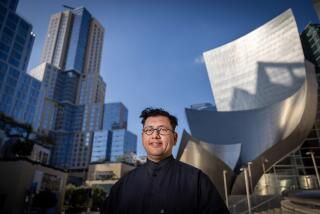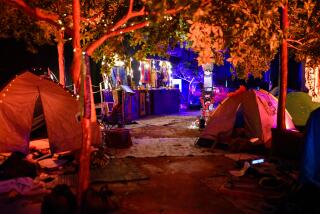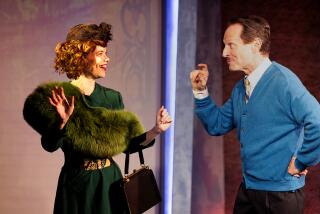‘Anne’ goes between the lines of Anne Frank’s diary
Los Angeles Mayor Eric Garcetti sat alone in a front-row folding chair before the start of a news conference at the Simon Wiesenthal Center’s Museum of Tolerance. He had just emerged from the museum’s brand-new Anne Frank exhibition, which opens to the public Tuesday, and was visibly moved.
“It was incredibly powerful,” Garcetti said. “It’s one of those visceral and transcendent exhibits — it hits you in the heart and the gut.”
Gov. Jerry Brown also took time out of his schedule to attend the Monday VIP ribbon-cutting of “Anne,” an interactive and fully immersive experience that honors the life and legacy of the teenager, who died in a Nazi concentration camp but left behind a diary that gave voice to the 1.5 million Jewish children murdered in the Holocaust.
“We’re very busy, but I don’t think we should ever be too busy to look back and to reflect on the influences that shape us even now,” Brown said during the news conference. “Evil is never that far away. The power of the mind, its distortions, its desires and its corruption can wreak the havoc that we see portrayed here during World War II.”
During the almost two years that Frank spent hiding from the Nazis in a secret annex behind her father’s office in Amsterdam, she longed for freedom and to one day travel to Hollywood and become a movie star. Her makeshift attic bedroom was plastered with pictures torn from movie magazines, and she cherished a wistful-looking, black-and-white portrait of herself.
“This is a photograph of me as I wish I looked all the time,” she wrote in her diary. “Then I might still have a chance of getting to Hollywood.”
It is not by accident that the museum’s newest permanent exhibition honors the teenage girl’s unfulfilled dreams. The exhibition entrance is marked by a mural featuring passages from Frank’s diary, her photo superimposed over the text. The mural faces a wall of windows looking northeast. Over the rooftops, through the telephone wires and sun-scorched tree tops, is the Hollywood sign.
It’s a poignant and oddly uplifting start to such a weighty exhibition. That is part of what the museum is aiming for — to give historical context to Frank’s story, highlighting the brutal horrors of war and the Holocaust while also preserving Frank’s spirit and even optimism under such atrocious circumstances.
PHOTOS: Arts and culture in pictures by The Times
“Putting this in its proper context is critically important to us,” museum director Liebe Geft said during a private walk-through last week. “We all think we know Anne. But we have the opportunity to rediscover her in a very intimate way, in her own words, and understand not only the authenticity of the story, but the truths behind it and the ramifications for us today.”
The $4-million exhibition, which took more than a year and a half to create, includes a wall of silent, archival film footage — flickering black-and-white images shot with an unsteady hand — of life on the streets of pre-war Amsterdam, when Frank lived there. It shows bustling intersections, rushed shoppers, passing cars. In one shot, Frank herself hangs her head over a balcony, smiling, her hair blowing in the wind. It’s the only existing film footage of her, Geft said.
The roughly 60-minute “experience,” as Geft called it, leads the visitor on a timed journey that incorporates eight short films and touch screens that play off of Frank’s words to prompt visitors to think deeply about their own lives. Particularly powerful is a widescreen film re-creation conveying what it felt like to live in secret, locked up in the attic — the hushed meals and cramped quarters, the pangs of first love and stifled adolescent longing, the terror of gunfire going off nightly outside the attic windows.
There are traditional display cases featuring both original and re-created objects, such as Jewish passports and yellow felt Stars of David worn by Jewish residents, handwritten letters between Frank and her sister, Margot, and their Iowa-based pen pals, Betty Ann and Juanita Wagner, and ice skates as Frank might have worn. What sets these otherwise static displays apart and brings them to life is the omnipresence of Frank’s own words, scrawled on the walls, wrapped around museum pillars and heard in ongoing, almost relentless audio narration, read from Frank’s diary by Oscar-nominated actress Hailee Steinfeld (“True Grit”). The result is robust and uncomfortably intimate.
“Telling this story is an honor, but it was really hard,” Steinfeld said Monday. “The responsibility of capturing everything Anne felt and putting her own thoughts into her own words was definitely a challenge — but I’m so glad to have done it.”
CHEATSHEET: Fall arts preview 2013
In addition to the Steinfeld-read diary passages, an actual recording of the same Western Church bells that sounded every 15 minutes near the imprisoned Frank’s attic window — and which she loved — ring in the museum. Audio from the short films play over and over in the background, fading in and out as guests pass. One film shows an interview with Frank’s only living relative, her first cousin Buddy Elias in Basel, Switzerland, which the museum recorded for the exhibition. Upon exiting, one hears the cacophonous, freedom-eliciting sound of birds chirping.
A wall of clothing that wraps around the exhibition functions as a sort of omniscient narrator; it changes color and position throughout, fading from pink and orange pastels during Frank’s childhood to sickly gray and black as her story progresses. The wall leans in at times to create a somewhat narrow, claustrophobic experience and it opens up at the end, to punctuate the optimism of the future.
“We call it the infinity wall,” said the exhibition’s senior designer, Yazdani Studio of Cannon Design’s Hansol Park. “The idea is to carry Anne’s story through generations.”
The “Anne” exhibition is uniquely personal to the museum, Geft said. It was Simon Wiesenthal who tracked down the Nazi officer, Karl Silberbauer, who arrested Anne Frank and had the family shipped off to a concentration camp.
When the play “The Diary of Anne Frank” was produced in Austria in 1957, “the neo-Nazis were saying this was all a fraud,” Geft said. “Simon made it his mission to find the Gestapo officer who made the arrest and who could vouch for the veracity of the existence of this child and her diary. So we have a unique angle.”
Like the exhibition itself, which ends on an uplifting note, so did Monday’s VIP opening. A small reception was held after the news conference, in the rotunda overlooking the museum’s towering outdoor menorah sculpture in the memorial plaza that, on this early fall afternoon, glinted in the sunlight.
As guests munched on cheese, crackers and knishes, VIP tours of the exhibition were held and occasional cheers could be heard down the hall as people — trustees, politicians and donors — posed for photos while clipping their portion of the red ribbon.
No one looked happier than Rabbi Marvin Hier, founder and dean of the Simon Wiesenthal Center, who wandered through the crowd shaking hands and receiving congratulations.
“This is fantastic, unbelievable,” he said, beaming. “This is a significant, historic day for the Simon Wiesenthal Center. Hundreds of thousands of children will come to see this. Outside of Amsterdam, this is the largest Anne Frank exhibit in the world. So we’re very, very proud.”
----------------------------------
‘Anne’
Where: The Museum of Tolerance, Simon Wiesenthal Plaza, 9786 W. Pico Blvd., Los Angeles
When: Opens to public Tuesday. 11 a.m. to 5 p.m. Sunday, 10 a.m. to 5 p.m. Monday to Wednesday and Friday, 10 a.m. to 9:30 p.m. Thursday
Tickets: Adults $15.50, students with ID and youths 5-18 $12.50, seniors $13.50, free for members
Contact: (310) 772-2506 or https://www.museumoftolerance.com
More to Read
The biggest entertainment stories
Get our big stories about Hollywood, film, television, music, arts, culture and more right in your inbox as soon as they publish.
You may occasionally receive promotional content from the Los Angeles Times.











